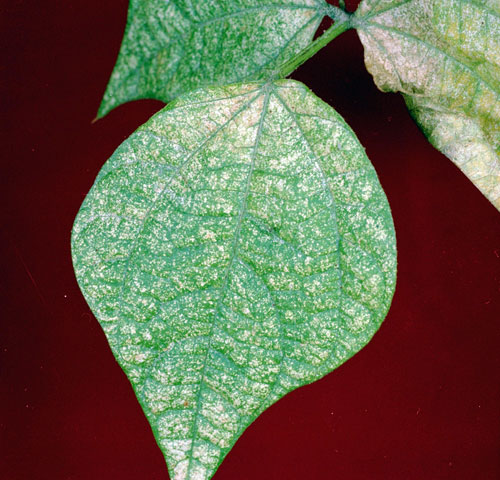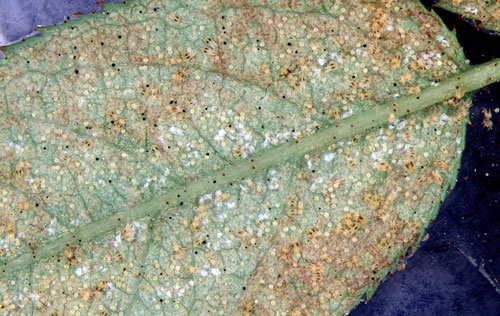Spider mite populations thrive in hot dry summers
Begin scouting vegetable gardens, berries and landscape plants for the first signs of a spider mite problem.
We had our first sample of soybeans in the lab this week with extremely high numbers of twospotted spider mites. We expect some landscape broad leaf trees, shrubs and perennials will soon begin to show high mite numbers and injury too.
Spider mites (Acari: Tetranychidae) are among the most common and destructive of all plant pests. They thrive during summers that are particularly hot and dry. Some spider mite species are very specific and feed on only one type of host plant. Others, like the twospotted spider mite, seem to be able to feed on many plant species including weeds, vegetables, flowers, field and forage crops, brambles and other small fruits, tree fruits, greenhouse plants, and certain trees and shrubs. Hot, dry weather favors rapid development and reproduction. The twospotted spider mite can go from an egg to an adult in only five days at 75 degrees. The female lives 2 to 4 weeks and produces about 100 to 300 eggs.
Spider mites feed on plant juices by abrading the leaf surface with their pointed mouthparts, and then sucking the sap that bleeds from the wound. Symptoms of spider mite feeding are yellowing, bronzing and speckling of the leaves and the presence of webbing. Extreme numbers will cause complete browning and leaf death. Most spider mites prefer new growth.
Spider mite populations are usually kept in check by natural enemies. During favorable conditions and high mite populations, a miticide application may be warranted to protect plants from serious injury. During the summer months, the least disruptive method of control for perennials and woody ornamentals is applying a 1 1/2% oil spray. Complete coverage is important when using oils. Be sure to use a high quality summer oil, such as Sun Spray Ultra Fine Oil, to prevent injuring the leaves. Be careful when using summer oils; they should only be applied when the new leaves are fully expanded. Yellowing and premature leaf drop can occur if they are applied when young leaves are expanding.
Other excellent products for controlling spider mites on trees and shrubs are Avid, Savey and Hexygon. Unfortunately, these are only available to professional tree care companies and other commercial applicators. Hexygon kills spiders but does not affect the predator mites.
Homeowners have limited products available to them for controlling spider mites on shrubs and shade trees: these include bifenthrin (sold as Ortho® Bug-B-Gon MAX® Lawn & Garden Insect Killer Concentrate ), malathion or horticultural oil (at the rate of 1 1/2%). Because of the mite’s rapid development and high reproductive rates, repeated treatments at 10-day intervals may be required for some plants to bring about satisfactory control. Remember, the long-term goal should be preserving and, if necessary, restoring the natural enemy populations that will keep the spider mite numbers low enough to prevent injury to the tree.
Whitney.S. Cranshaw and D.C. Sclar with Colorado State University put together the following table of information on the chemical control of spider mites (modified slightly).
|
Pesticides useful to control spider mites in yards and gardens. |
||
|
Active Ingredient |
Trade Name(s) |
Comments |
|
acephate |
Orthene, certain Isotox formulations |
Insecticide with some effectiveness against spider mites. Systemic. |
|
abamectin |
Avid |
For commercial use only on ornamental plants. Primarily effective against twospotted spider mite; less effective against mites on conifers. Limited systemic movement. |
|
bifenthrin |
Talstar, Ortho® Bug-B-Gon, others |
A widely available insecticide with good miticide activity. Can be used on vegetables, fruit trees and berries. |
|
hexythiazox |
Hexygon |
For commercial use only on ornamental plants. Selective miticide that affects developing stages and eggs only. One application per season label restriction. |
|
horticultural oils |
Sunspray, others |
Used at the "summer oil" rate (1 ½ percent), oils are perhaps the most effective miticides available for home use. |
|
insecticidal soap |
several |
Marginally effective against twospotted spider mite and where webbing prevents penetration. Broadly labeled. |
|
malathion |
several |
A widely available insecticide with good mite miticide activity that breaks down quickly. Can be used on vegetables, fruit trees and berries. |
|
spiromesifan |
Forbid |
For commercial use only on ornamental plants. Selective against mites and conserves natural enemies. |
Be sure to read and follow all the instructions and safety precautions found on the pesticide label before using any pesticide.

Speckling and bronzing are typical signs of spider injury.
Photo credit: Clemson University - USDA Cooperative Extension Slide Series, Courtesy of Bugwood.org.

Spider mites are visible on the underside of leaves with a 10x lens. Look
for webbing too. Photo credit: Whitney Cranshaw, Colorado State University, Courtesy of Bugwood.org.
Additional information
- MSU Extension’s Drought Resources



 Print
Print Email
Email



